engine CITROEN C3 2023 Owners Manual
[x] Cancel search | Manufacturer: CITROEN, Model Year: 2023, Model line: C3, Model: CITROEN C3 2023Pages: 104, PDF Size: 2.38 MB
Page 4 of 104
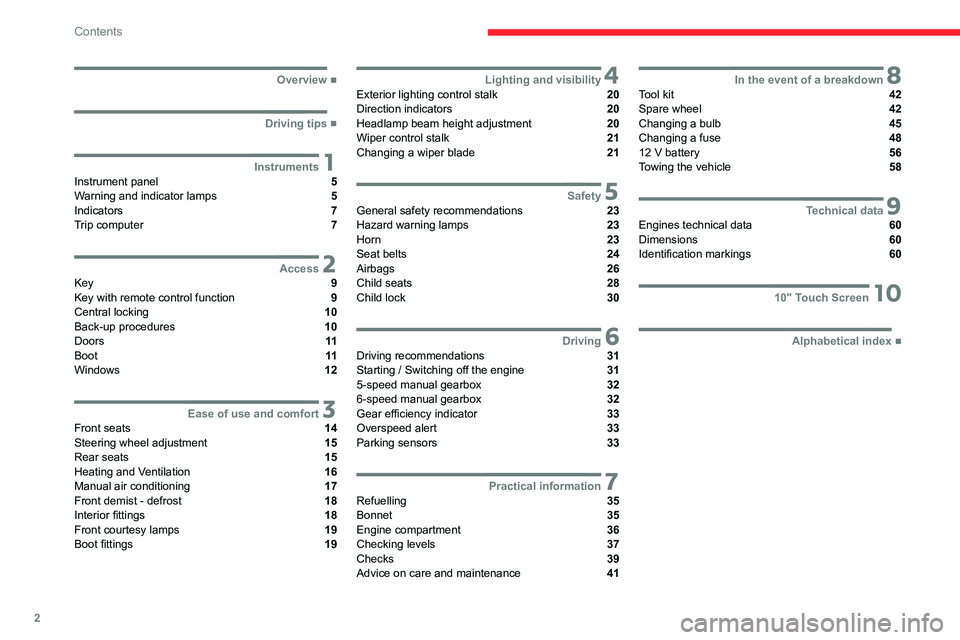
2
Contents
■
Overview
■
Driving tips
1InstrumentsInstrument panel 5
Warning and indicator lamps 5
Indicators 7
Trip computer 7
2AccessKey 9
Key with remote control function 9
Central locking 10
Back-up procedures 10
Doors 11
Boot 11
Windows 12
3Ease of use and comfortFront seats 14
Steering wheel adjustment 15
Rear seats 15
Heating and Ventilation 16
Manual air conditioning 17
Front demist - defrost 18
Interior fittings 18
Front courtesy lamps 19
Boot fittings 19
4Lighting and visibilityExterior lighting control stalk 20
Direction indicators 20
Headlamp beam height adjustment 20
Wiper control stalk 21
Changing a wiper blade 21
5SafetyGeneral safety recommendations 23
Hazard warning lamps 23
Horn 23
Seat belts 24
Airbags 26
Child seats 28
Child lock 30
6DrivingDriving recommendations 31
Starting / Switching off the engine 31
5-speed manual gearbox 32
6-speed manual gearbox 32
Gear efficiency indicator 33
Overspeed alert 33
Parking sensors 33
7Practical informationRefuelling 35
Bonnet 35
Engine compartment 36
Checking levels 37
Checks 39
Advice on care and maintenance 41
8In the event of a breakdownTool kit 42
Spare wheel 42
Changing a bulb 45
Changing a fuse 48
12
V battery 56
Towing the vehicle 58
9Technical dataEngines technical data 60
Dimensions 60
Identification markings 60
1010" Touch Screen
■
Alphabetical index
Page 6 of 104
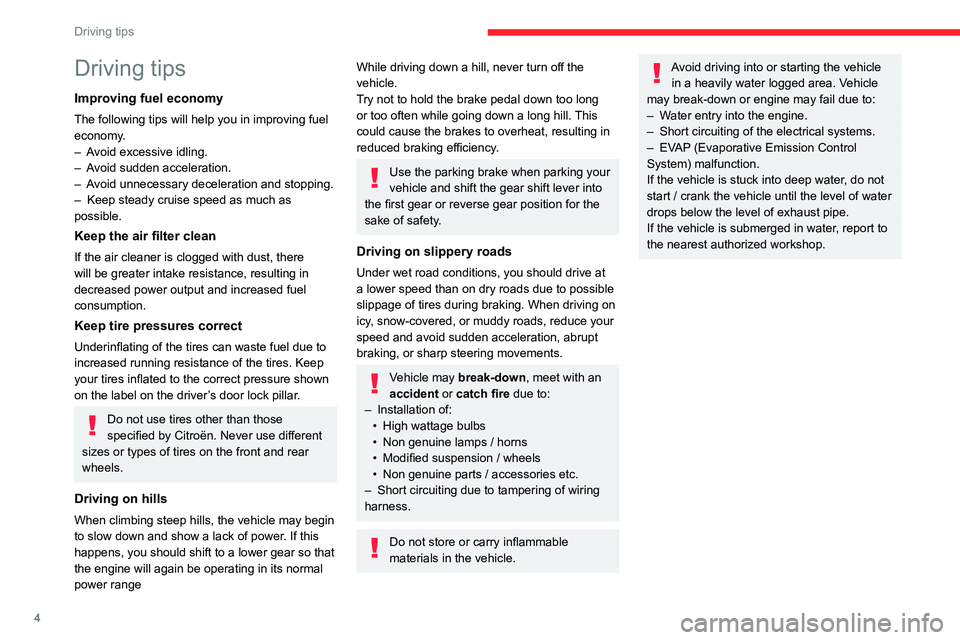
4
Driving tips
Driving tips
Improving fuel economy
The following tips will help you in improving fuel
economy.
–
A
void excessive idling.
–
A
void sudden acceleration.
–
A
void unnecessary deceleration and stopping.
–
Keep steady cruise speed as much as
possible.
Keep the air filter clean
If the air cleaner is clogged with dust, there
will be greater intake resistance, resulting in
decreased power output and increased fuel
consumption.
Keep tire pressures correct
Underinflating of the tires can waste fuel due to
increased running resistance of the tires. Keep
your tires inflated to the correct pressure shown
on the label on the driver’s door lock pillar.
Do not use tires other than those
specified by Citroën. Never use different
sizes or types of tires on the front and rear
wheels.
Driving on hills
When climbing steep hills, the vehicle may begin
to slow down and show a lack of power. If this
happens, you should shift to a lower gear so that
the engine will again be operating in its normal
power range
While driving down a hill, never turn off the
vehicle.
Try not to hold the brake pedal down too long
or too often while going down a long hill. This
could cause the brakes to overheat, resulting in
reduced braking efficiency.
Use the parking brake when parking your
vehicle and shift the gear shift lever into
the first gear or reverse gear position for the
sake of safety.
Driving on slippery roads
Under wet road conditions, you should drive at
a lower speed than on dry roads due to possible
slippage of tires during braking. When driving on
icy, snow-covered, or muddy roads, reduce your
speed and avoid sudden acceleration, abrupt
braking, or sharp steering movements.
Vehicle may break-down, meet with an
accident or catch fire due to:
–
Installation of:
•
High wattage bulbs
•
Non genuine lamps / horns
•
Modified suspension / wheels
•
Non genuine parts / accessories etc.
–
Short circuiting due to tampering of wiring
harness.
Do not store or carry inflammable
materials in the vehicle.
Avoid driving into or starting the vehicle in a heavily water logged area. Vehicle
may break-down or engine may fail due to:
–
W
ater entry into the engine.
–
Short circuiting of the electrical systems.
–
EV
AP (Evaporative Emission Control
System) malfunction.
If the vehicle is stuck into deep water, do not
start / crank the vehicle until the level of water
drops below the level of exhaust pipe.
If the vehicle is submerged in water, report to
the nearest authorized workshop.
Page 7 of 104
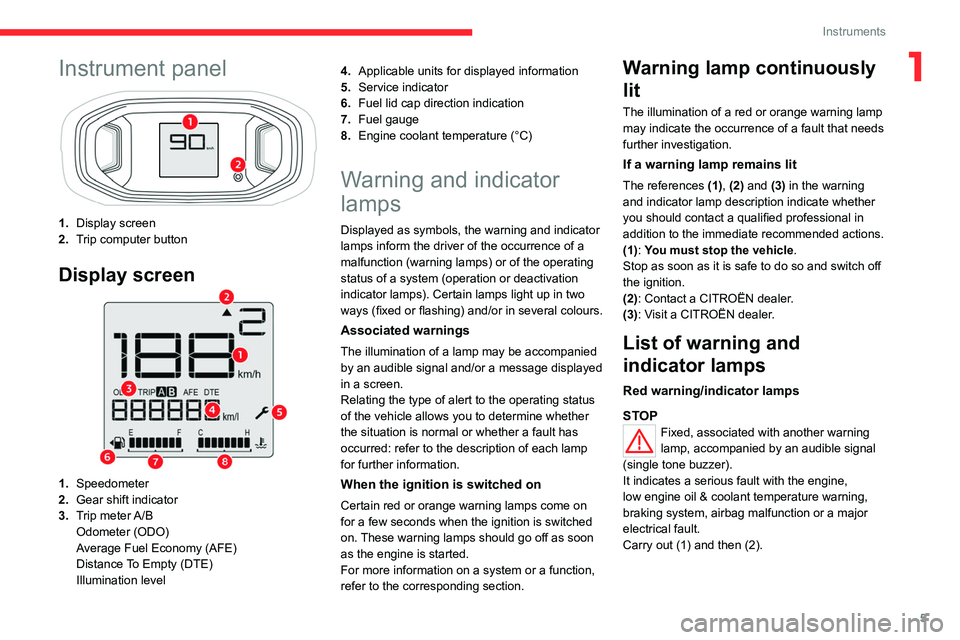
5
Instruments
1Instrument panel
1.Display screen
2. Trip computer button
Display screen
1.Speedometer
2. Gear shift indicator
3. Trip meter A/B
Odometer (ODO)
Average Fuel Economy (AFE)
Distance To Empty (DTE)
Illumination level 4.
Applicable units for displayed information
5. Service indicator
6. Fuel lid cap direction indication
7. Fuel gauge
8. Engine coolant temperature (°C)
Warning and indicator
lamps
Displayed as symbols, the warning and indicator
lamps inform the driver of the occurrence of a
malfunction (warning lamps) or of the operating
status of a system (operation or deactivation
indicator lamps). Certain lamps light up in two
ways (fixed or flashing) and/or in several colours.
Associated warnings
The illumination of a lamp may be accompanied
by an audible signal and/or a message displayed
in a screen.
Relating the type of alert to the operating status
of the vehicle allows you to determine whether
the situation is normal or whether a fault has
occurred: refer to the description of each lamp
for further information.
When the ignition is switched on
Certain red or orange warning lamps come on
for a few seconds when the ignition is switched
on. These warning lamps should go off as soon
as the engine is started.
For more information on a system or a function,
refer to the corresponding section.
Warning lamp continuously
lit
The illumination of a red or orange warning lamp
may indicate the occurrence of a fault that needs
further investigation.
If a warning lamp remains lit
The references (1), (2) and (3) in the warning
and indicator lamp description indicate whether
you should contact a qualified professional in
addition to the immediate recommended actions.
(1): You must stop the vehicle .
Stop as soon as it is safe to do so and switch off
the ignition.
(2): Contact a CITROËN dealer.
(3): Visit a CITROËN dealer.
List of warning and
indicator lamps
Red warning/indicator lamps
STOP
Fixed, associated with another warning
lamp, accompanied by an audible signal
(single tone buzzer).
It indicates a serious fault with the engine,
low engine oil & coolant temperature warning,
braking system, airbag malfunction or a major
electrical fault.
Carry out (1) and then (2).
Page 8 of 104
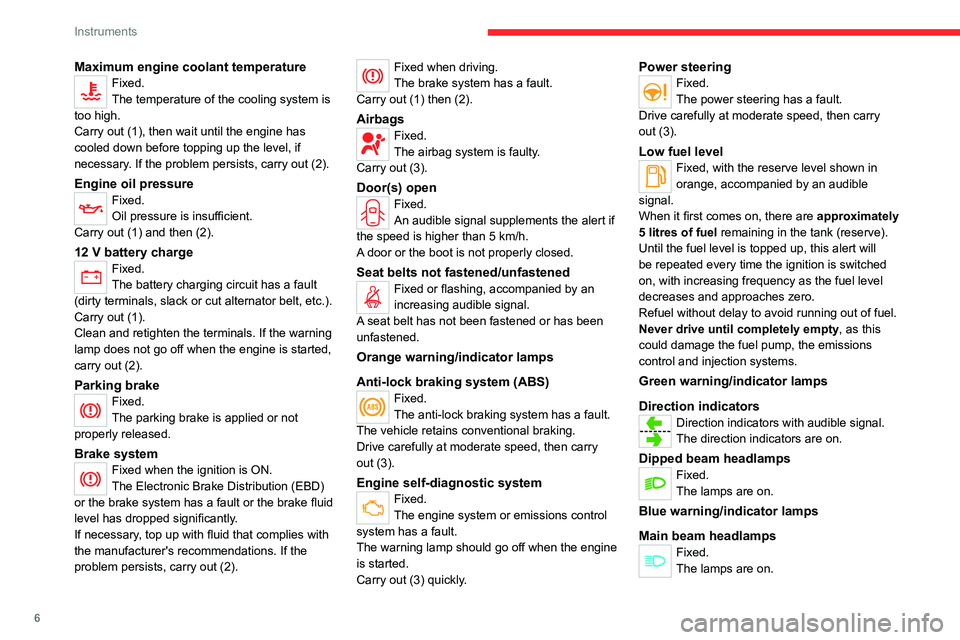
6
Instruments
Maximum engine coolant temperatureFixed.
The temperature of the cooling system is
too high.
Carry out (1), then wait until the engine has
cooled down before topping up the level, if
necessary. If the problem persists, carry out (2).
Engine oil pressureFixed.
Oil pressure is insufficient.
Carry out (1) and then (2).
12 V battery chargeFixed.
The battery charging circuit has a fault
(dirty terminals, slack or cut alternator belt, etc.).
Carry out (1).
Clean and retighten the terminals. If the warning
lamp does not go off when the engine is started,
carry out (2).
Parking brakeFixed.
The parking brake is applied or not
properly released.
Brake systemFixed when the ignition is ON.
The Electronic Brake Distribution (EBD)
or the brake system has a fault or the brake fluid
level has dropped significantly.
If necessary, top up with fluid that complies with
the manufacturer's recommendations. If the
problem persists, carry out (2).
Fixed when driving.
The brake system has a fault.
Carry out (1) then (2).
AirbagsFixed.
The airbag system is faulty.
Carry out (3).
Door(s) openFixed.
An audible signal supplements the alert if
the speed is higher than 5
km/h.
A door or the boot is not properly closed.
Seat belts not fastened/unfastenedFixed or flashing, accompanied by an
increasing audible signal.
A seat belt has not been fastened or has been
unfastened.
Orange warning/indicator lamps
Anti-lock braking system (ABS)
Fixed.
The anti-lock braking system has a fault.
The vehicle retains conventional braking.
Drive carefully at moderate speed, then carry
out (3).
Engine self-diagnostic systemFixed.
The engine system or emissions control
system has a fault.
The warning lamp should go off when the engine
is started.
Carry out (3) quickly.
Power steeringFixed.
The power steering has a fault.
Drive carefully at moderate speed, then carry
out (3).
Low fuel levelFixed, with the reserve level shown in
orange, accompanied by an audible
signal.
When it first comes on, there are
approximately
5 litres of fuel remaining in the tank (reserve).
Until the fuel level is topped up, this alert will
be repeated every time the ignition is switched
on, with increasing frequency as the fuel level
decreases and approaches zero.
Refuel without delay to avoid running out of fuel.
Never drive until completely empty, as this
could damage the fuel pump, the emissions
control and injection systems.
Green warning/indicator lamps
Direction indicators
Direction indicators with audible signal.
The direction indicators are on.
Dipped beam headlampsFixed.
The lamps are on.
Blue warning/indicator lamps
Main beam headlamps
Fixed.
The lamps are on.
Page 9 of 104

7
Instruments
1Black/white warning lamps
Service
Flashing.
A fault has been detected.
Carry out (3).
Fixed.
The servicing interval has been
exceeded.
Your vehicle must be serviced as soon as
possible. Carry out (3).
Indicators
Service indicator
The vehicle servicing must be done according to
the distance covered (kilometres or miles) or the
time elapsed since the last service.
The servicing alert is given at whichever of these
two terms is reached first.
Service indicatorFixed, when the ignition is switched on.
The next service is due.
Have your vehicle serviced very soon.
Engine coolant temperature
indicator
With the engine running:
– In zone A, the temperature is correct.
–
In zone
B, the temperature is too high; the
associated warning lamp comes on in red on the
instrument panel, accompanied by an audible
signal.
You must stop the vehicle as soon as it is
safe to do so.
Wait a few minutes before switching off the
engine.
After switching off the ignition, carefully open the bonnet and check the coolant
level.
For more information on Checking
levels, refer to the corresponding
section.
Trip computer
Data displayed
► Make a short press on the button located
on the instrument panel to display and switch
between the following information:
–
Odometer
–
T
rip A
–
T
rip B
–
A
verage Fuel Economy (AFE)
–
Distance
To Empty (DTE)
–
Illumination level (park lamp on then press the
trip button to adjust the illumination level of the
cluster)
Page 11 of 104
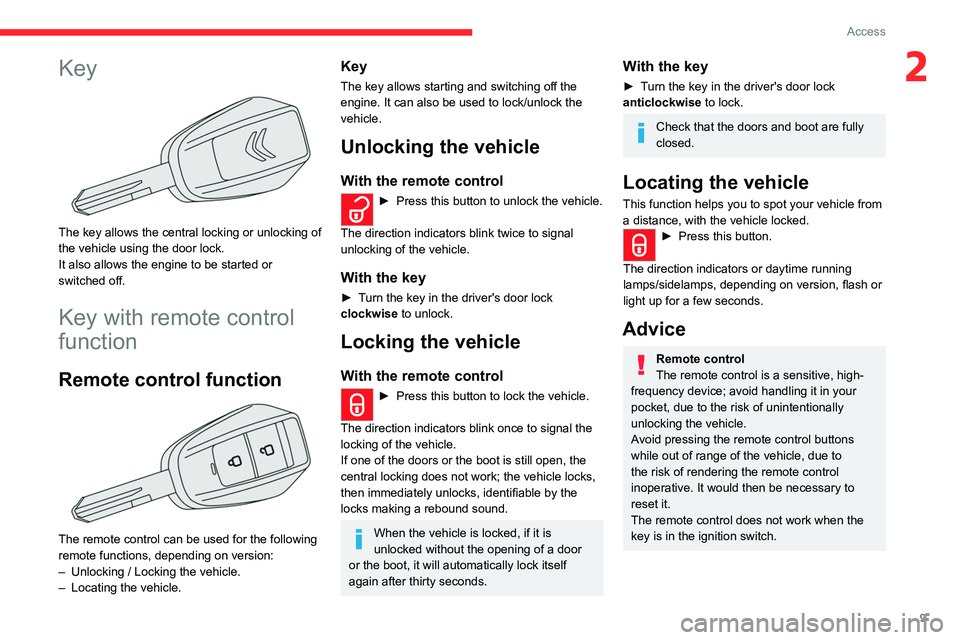
9
Access
2Key
The key allows the central locking or unlocking of
the vehicle using the door lock.
It also allows the engine to be started or
switched off.
Key with remote control
function
Remote control function
The remote control can be used for the following
remote functions, depending on version:
–
Unlocking / Locking the vehicle.
–
Locating the vehicle.
Key
The key allows starting and switching off the
engine. It can also be used to lock/unlock the
vehicle.
Unlocking the vehicle
With the remote control
► Press this button to unlock the vehicle.
The direction indicators blink twice to signal
unlocking of the vehicle.
With the key
► Turn the key in the driver's door lock
clockwise to unlock.
Locking the vehicle
With the remote control
► Press this button to lock the vehicle.
The direction indicators blink once to signal the
locking of the vehicle.
If one of the doors or the boot is still open, the
central locking does not work; the vehicle locks,
then immediately unlocks, identifiable by the
locks making a rebound sound.
When the vehicle is locked, if it is
unlocked without the opening of a door
or the boot, it will automatically lock itself
again after thirty seconds.
With the key
► Turn the key in the driver's door lock
anticlockwise to lock.
Check that the doors and boot are fully
closed.
Locating the vehicle
This function helps you to spot your vehicle from
a distance, with the vehicle locked.
► Press this button.
The direction indicators or daytime running
lamps/sidelamps, depending on version, flash or
light up for a few seconds.
Advice
Remote control
The remote control is a sensitive, high-
frequency device; avoid handling it in your
pocket, due to the risk of unintentionally
unlocking the vehicle.
Avoid pressing the remote control buttons
while out of range of the vehicle, due to
the risk of rendering the remote control
inoperative. It would then be necessary to
reset it.
The remote control does not work when the
key is in the ignition switch.
Page 33 of 104

31
Driving
6Driving recommendations
► Observe the driving regulations and remain
vigilant whatever the traffic conditions.
►
Monitor your environment and keep your
hands on the wheel to be able to react to
anything that may happen any time.
►
Drive smoothly
, anticipate the need for
braking and maintain a longer safety distance,
especially in bad weather.
►
Stop the vehicle to carry out operations that
require close attention (such as adjustments).
►
During long trips, take a break every two
hours.
Important!
Never leave the engine running in a
closed space without sufficient
ventilation. Internal combustion engines emit
toxic exhaust gases such as carbon
monoxide. Danger of poisoning and death!
In severe wintry conditions, let the engine
run for 4 minutes before moving off, to
ensure the correct operation and durability of
the mechanical components of your vehicle
(engine and gearbox).
Never drive with the parking brake
applied . Risk of overheating and
damage to the braking system!
Do not park the vehicle or leave the
engine running on a flammable
surface (dry grass, dead leaves, etc.). The
exhaust system of your vehicle is very hot,
even several minutes after the engine stops.
Risk of fire!
Never leave a vehicle unattended with
the engine running. If you have to leave
your vehicle with the engine running, apply
the parking brake and put the gearbox into
neutral.
Never leave children inside the vehicle
unsupervised.
On flooded roads
We strongly advise against driving on flooded
roads, as this could cause serious damage to
the engine or gearbox, as well as to the electrical
systems of your vehicle.
If you have to drive on a flooded road:
► drive as slowly as possible without stalling. In
all cases, do not exceed 10
km/h,►
do not stop and do not switch off the engine.
On leaving the flooded road, as soon as safety
conditions allow
, make several light brake
applications to dry the brake discs and pads.
If in doubt about the state of your vehicle,
contact a CITROËN dealer.
Starting / Switching off the
engine
Key ignition switch
It has 4 positions:
1. Stop Inserting and removing the key, steering
column locked.
2. ACC Steering column unlocked, use of the
vehicle's electric equipment.
3. ON (Ignition) Steering column unlocked, ignition on, engine
running.
4. Starting
Page 34 of 104

32
Driving
Avoid attaching heavy objects to the key or the remote control. It would weigh
down on its shaft in the ignition switch and
could cause a malfunction.
Ignition on position
It allows the use of the vehicle's electric
equipment or portable devices to be charged.
Starting the engine
With the parking brake applied:
► Place the gear lever in neutral then fully
depress the clutch pedal.
►
Insert the key into the ignition switch; the
system recognises the code.
►
Unlock
the steering column by simultaneously
turning the steering wheel and the key.
In certain cases, you may have to apply
significant force to move the steering
wheel (wheels on full lock, for example).
►
Operate the starter motor by turning the key
to position
3 without pressing the accelerator
pedal, until the engine starts. Once the engine
starts, release the key.
After a cold start, preheating the catalytic converter can cause noticeable engine
vibrations for anything up to 2 minutes while
stationary with the engine running
(accelerated idle speed).
If the engine does not start straight away,
switch off the ignition. Wait a few
seconds before operating the starter motor
again. If the engine does not start after a few
attempts, do not keep trying - risk of
damaging the starter motor, the battery and
the engine.
Contact a CITROËN dealer.
In mild conditions, do not leave the
engine at idle to warm up but move off
straight away and drive at moderate speed.
5-speed manual gearbox
Engaging reverse gear
► Fully depress the clutch pedal.
► Push the gear lever fully to the right, then
backwards.
Only engage reverse gear when the
vehicle is stationary with the engine at
idle.
As a safety precaution and to facilitate starting the engine:
–
Always select neutral.
–
Depress the clutch pedal.
6-speed manual gearbox
Engaging 5th or 6th gear
► Move the gear selector fully to the right to
engage 5th or 6th gear.
Failure to follow this instruction could
cause permanent damage to the gearbox
(inadvertent engagement of 3
rd or 4th gear).
Engaging reverse gear
► Raise the ring under the knob and move the
gear selector to the left, then forwards.
Page 35 of 104

33
Driving
6Only engage reverse gear when the
vehicle is stationary with the engine at
idle.
As a safety precaution and to facilitate starting the engine:
–
Always select neutral.
–
Press the clutch pedal.
Gear efficiency indicator
This system helps reduce fuel consumption by
recommending the most appropriate gear.
Operation
The system advises to change gear.The information appears in the instrument panel in the form of an ascending or
descending arrow.
The number displayed is the current gear.
Gear shift recommendations should not be
considered compulsory. In fact, the road layout,
the traffic density and safety remain the deciding
factors when choosing the best gear. The driver
therefore remains responsible for deciding
whether or not to follow the indications issued by
the system.
This function cannot be deactivated.
The system adapts its gear shift recommendation according to the driving
conditions (slope, load, etc.) and the driver’s
requirements (power, acceleration, braking,
etc.).
The system never suggests:
–
engaging first gear;
–
engaging reverse.
Overspeed alert
An audible overspeed alert is triggered when the
vehicle exceeds predefined speed thresholds.
When the vehicle speed is greater than 80 km/h,
the alert is emitted every 2 minutes.
When the vehicle speed is greater than 120
km/h, the alert is emitted every 2 seconds.
This system cannot be modified nor deactivated.
Parking sensors
Using sensors located in the bumper, this
system signals the proximity of obstacles
(e.g.
pedestrian, vehicle, tree, barrier) present in
their field of detection.
Rear parking sensors
The system is switched on by engaging reverse
gear.
The system is switched off when disengaging
reverse gear.
Audible assistance
The system signals the presence of obstacles
within the sensors’ detection zone.
The proximity information is given by an
intermittent audible signal, the frequency of
which increases as the vehicle approaches the
obstacle.
When the distance between the vehicle
and the obstacle becomes less than about
60
centimetres, the audible signal becomes
continuous.
Operating limits
If the boot is heavily loaded, the vehicle may tilt,
affecting distance measurements.
Page 37 of 104

35
Practical information
7Refuelling
Fuel tank capacity: 30 litres.
Reserve level: approximately 5 litres.
Low fuel level
When the low fuel level is reached, this
warning lamp comes on on the instrument
panel, accompanied by an audible signal. When
it first comes on, about 5 litres of fuel remain.
Until sufficient fuel is added, this warning lamp
appears every time the ignition is switched on,
accompanied by an audible signal. When driving,
the audible signal are repeated with increasing
frequency as the fuel level drops towards 0.
You must refuel as soon as possible to avoid
running out of fuel.
Refuelling
Additions of fuel must be of at least 5 litres, in
order to be registered by the fuel gauge.
Opening the filler cap may create a noise caused
by an inrush of air. This vacuum is entirely
normal, resulting from the sealing of the fuel
system.
To refuel in complete safety:
►
Y
ou must switch off the engine.
► Lift the fuel filler flap lever , located on the
floor beside the driver's seat, to open the flap.
►
T
ake care to select the pump that delivers the
correct fuel type for the vehicle's engine (see a
reminder label on the inside of the filler flap).
► Turn the filler cap to the left and remove it.
► Introduce the filler nozzle and push it in as
far as possible before starting to refuel (risk of
blowback).
►
Fill the tank.
Do not continue past the first cut-off of the
nozzle, as this may cause malfunctions.
► Refit the filler cap.
► T urn it to the right.
►
Push the filler flap to close it.
If you have put in wrong/dirty/
contaminated fuel or H2O mixed fuel in
the vehicle, you must have the fuel tank
drained and filled with the correct fuel before
starting the engine.
Contact a CITROËN dealer for the fuel
system cleaning.
The vehicle is fitted with a catalytic converter, a
device which helps to reduce the level of harmful
emissions in the exhaust gases.
You must use unleaded fuel.
The filler neck is narrower, admitting unleaded
petrol nozzles only.
Fuel cut-off
Your vehicle is equipped with a safety device
which cuts off the fuel supply in the event of a
collision.
Bonnet
When the engine is hot, handle the
exterior safety catch and the bonnet stay
with care (risk of burns), using the protected
area.
When the bonnet is open, take care not to
damage the safety catch.